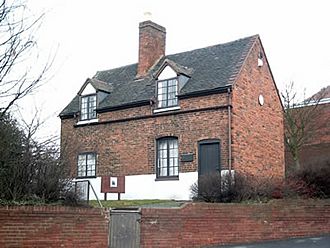Bishop Asbury Cottage facts for kids
Quick facts for kids Bishop Asbury Cottage |
|
|---|---|
 |
|
| General information | |
| Type | Cottage |
| Address | Newton Road, Great Barr, Sandwell, West Midlands, England |
| Coordinates | 52°32′35″N 1°57′18″W / 52.543101°N 1.955008°W |
| Construction started | c. 1700 |
| Owner | Sandwell Metropolitan Borough Council |
| Designations | Grade II listed |
Bishop Asbury Cottage (grid reference SP 03150 93920) is an old house in Great Barr, England. It was built in the 1600s. This cottage is famous because it was the childhood home of Francis Asbury. He became one of the first leaders, called bishops, of the Methodist Episcopal Church in the United States. Today, the cottage is a museum that tells his story.
Cottage Design
This cottage has only one main floor. It was built around the year 1700 using bricks. The roof is made of tiles. It also has small windows, called dormer windows, that stick out from the roof. These windows let light into the attic space.
Francis Asbury's Early Life
Francis Asbury was born in a nearby place called Hamstead in 1745. His family moved into this cottage the very next year. Asbury was a Methodist and went to church in Wednesbury. He learned to be a blacksmith when he was young. But by age 21, he decided to become a full-time preacher.
He left England for America in 1771. He never came back to England. His family stayed in the cottage until his mother, Eliza, passed away in 1802. While they lived there, the cottage was used for religious meetings. These meetings continued even after his parents were gone. Later, the church group moved to a building across the road. This building eventually became the Newton Road United Reformed Church, which closed in 2017.
The Cottage as a Museum
By the 1950s, a company that made drinks owned the cottage. It did not have running water or a modern toilet. A lady named Mrs. Randles and her daughter, Mrs. Searle, lived there. They often showed American Methodists who visited around the old house.
The company wanted to tear down the cottage. But a local politician, Mrs. Parfitt, who was also a Methodist, stopped them. She realized how important the cottage's history was. Around 1955, the local council bought the cottage. They helped Mrs. Randles and Mrs. Searle find a new home.
The cottage was once part of a pair of houses. But in 1964, the house next door was torn down. This happened when Newton Road was made wider. Some people thought the demolished house was Asbury's home. But old documents at Sandwell Museum show that this cottage was indeed the correct one.
Since September 1955, Bishop Asbury Cottage has been a special Grade II listed building. This means it is protected because of its history. Today, it is a museum. Inside, you can see furniture from the time Asbury lived there. There are also items and information about his life in England and later in the United States. The museum also teaches visitors about the rise of Methodism in the Black Country area. You can also learn about John Wesley, who was a very important person in the Methodist movement.
See also
- Charlemont and Grove Vale

